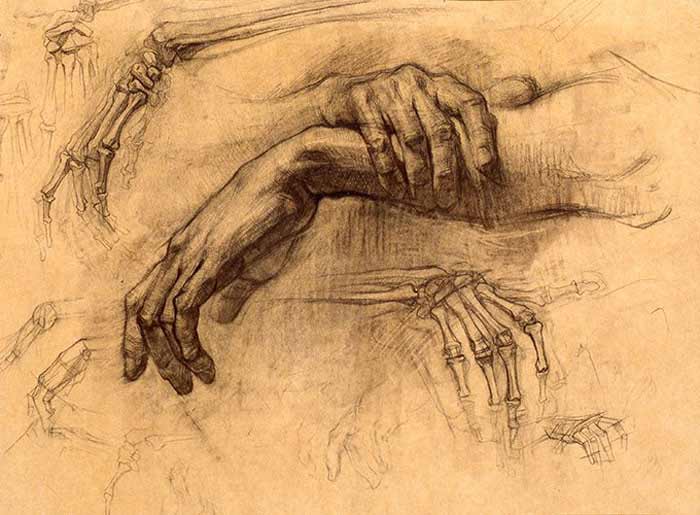Forearm Anatomy
Forearm Anatomy
Anatomy Lesson 11 – Part 2
In this video lesson, you will find out the forearm anatomy.
Forearm Anatomy for Figurative Artists
Some art students feel the pronation position of the forearm is difficult to draw. They may find this to be a challenge because they do not fully understand the bone and muscle anatomy of this part of the human body.
In this lesson, you will see how the forearm anatomy works.
Forearm anatomy – Bones
The is only one bone in the upper arm; it is called the humerus. This bone becomes wider at its lower end. This widening is to accommodate the elbow joint.
At the lower end of the humerus, there are two bony forms. One resembles a spool and the other looks like a ball.
The spool-shaped part connects with the ulna, which is the elbow bone of the lower arm.
The elbow joint is called a “hinge joint” because the ulna swings at the lower end of the humerus like a hinge.
The ball-shaped projection of the humerus connects with the other bone of the lower arm, the radius.
The head of the radius is wheel-shaped, so it makes a perfect connection with the ball-shaped projection of the humerus.
In the pronation position, the radius rotates around the ulna and overlaps it from above, forming an “X” shape.
The top of the ulna is wider than the bottom and, in reverse, the radius is wider at the bottom.
At the lower end, the ulna and the radius are connected to the wrist bones.
There are eight of these wrist bones, which are collectively known as carpal bones. These bones are laid into two rows.
The palm area of the hand consists of five metacarpal bones.


Each finger has three phalanges.
The proportion between the lengths of the metacarpal bone and the first phalange of a finger is equal to the Golden Ration.
The same is true for the proportion between the first and second phalanges as well as the second and the third phalanges of fingers.
The name metacarpal comes from the Greek words meta, meaning after, and karpos, meaning wrist. So, literally, metacarpal means after the wrist.
The knuckles of the fist are actually the heads of the metacarpal bones.
There are several joint types in the hand.
The joints between the wrist and the palm are called the carpometacarpal joints.
The joint between the palm and the finger is called the metacarpophalangeal joint. This joint is where you find the knuckles.
There are two more joints in the finger. They are the proximal interphalangeal joint and the distal interphalangeal joint.
The proximal interphalangeal joint is between the first and second phalanges and the distal joint is between the second and third phalanges of the finger.
In a relaxed hand and finger position, the palm and finger axes are arched.
The metacarpal bone of the thumb is the shortest. It travels sideways from the palm.
The axis of the thumb is rotated about 90 degrees from the rest of the fingers, which makes it very useful for gripping and holding objects.
Unlike the fingers, the thumb has only two phalanges.
When you draw a relaxed hand, you need to remember that the fingers will be slightly bent, with the little finger likely bent the most. This is because the little finger has many powerful flexor muscles attached to it.
Keep in mind, also, when drawing the fingers that the index finger, the ring finger, and the little finger likely will be bent toward the middle finger.
Forearm Anatomy – Muscles
There are two major groups of muscles in the forearm anatomy – the group that flexes the hand and the group that extends it.
The flexor group of the lower arm originates from the inner, lower edge of the humerus.
The muscles in this group spiral downward to the palm side of the hand and insert into various bones of the hand. The main action of these muscles is to flex the hand, or bring it closer to the arm.
The extensor group of the lower arm originates at the outer, lower edge of the humerus; it travels downward to the backside of the hand. The main function of this muscle group is to extend the hand.
The main mass of these two groups of muscles is located in the upper half of the lower arm. At the lower half of the forearm, these muscles become tendons. That is why the width of the arm near the wrist is defined by the width of two bones – the ulna and the radius.
The same is true for the elbow joint. The width of the elbow is defined by the size of the humerus at its lower end.
The flexor and the extensor muscles spiral along the lower arm bones. Whether the radius is rotated into a pronation, or located parallel to ulna in supination position, determines the direction of the muscles…
[ The full lesson is avaibale to Anatomy Master Class members ]
To learn more about the forearm anatomy, enrol in the Anatomy Master Class
Simple Pricing, No Surprises
One-time payment - Only $97 USD
ENROLL NOW



